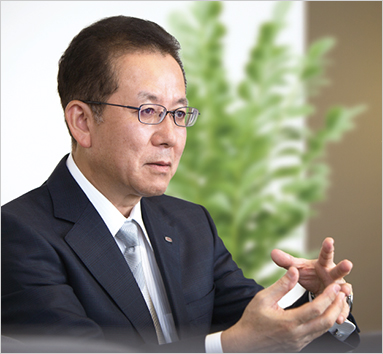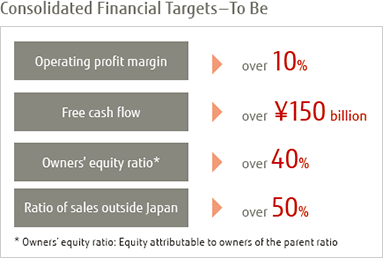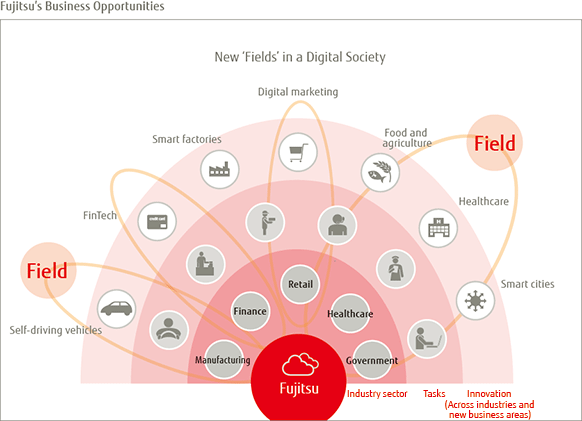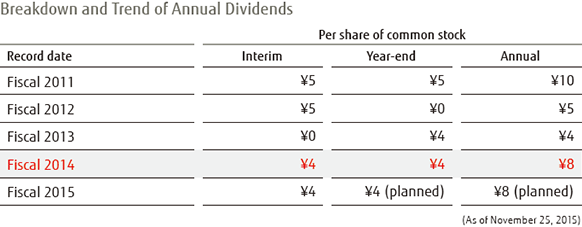Fujitsu Group Integrated Report 2015
- Message from Management
- Performance Highlights
- Message to Shareholders and Other Investors
- Value Creation Model
- Feature: Management Direction
- Dialogue: Fujitsu Seen by Its External Officers
Fujitsu is steadily moving forward with its business model transformation, working transformation, working to drive sustainable business growth so as to better compete in the global arena.

Today, advances in digital technology are driving innovation in every field. At Fujitsu, we see the market needs created by this change as major business opportunities. We will partner with our customers and leverage highly specialized ICT to help them create new value through their businesses.
The management direction that we announced in October 2015 outlined the main structure of Fujitsu's business model transformation for driving sustainable business growth going forward. We will steadily promote this business model transformation to transition to a structure that supports sustainable growth and global competitiveness as an ICT company.

After joining Fujitsu in 1980, I was involved in various business deals in the Japanese sales divisions, including some which were major wins. After that, I worked to strengthen our sales to Japanese companies in China, and in fiscal 2014, I was involved in structural reforms as the Head of the Asia Region.
From these experiences, I have learned that the fundamental task in promoting business is to focus clearly on the frontline realities of the customer, and that of the customers' customers, in providing products and services.
Looking ahead, markets will become increasingly global. Fujitsu aims to be a globally competitive company, and we will strengthen our global competitiveness even further based on the global matrix organization that we launched in 2014.
In step with the march of globalization, our customers' business models are changing dramatically. ICT is steadily making inroads into fields where it had never been used. Keeping our focus on the realities of the front line, we will acquire a clear grasp of the changes affecting our customers. If the value we provide is not recognized by our customers, it will ultimately fail to deliver profits.
It is also important as a global company to ensure that we execute this change swiftly.
Fujitsu can also leverage its strengths in new domains by working with customers to co-create new services utilizing its technologies, expertise, and experience. As a company, we aim to achieve a good balance between proactivity, flexibility, and having a mindset to take on challenges.
Fujitsu is fortunate to have superb human resources. Throughout our 80-year history, Fujitsu has worked ambitiously on various projects, building up the Company's technical capabilities, experience, expertise, and other aspects to form extremely valuable assets. I am confident that concentrating these assets in our target direction and managing them properly will create synergistic effects that will result in a stronger company.
We targeted fiscal 2014 for a shift to a growth strategy, having achieved a certain amount of progress in our structural reforms of the LSI device business and mobile phone business in the previous fiscal year, and conducted aggressive strategic investments for medium- to long-term growth. These efforts were supported by the effect of improvements associated with the structural reforms conducted in the previous fiscal year and growth in demand, mainly in the domestic services business.
Revenue was ¥4,753.2 billion, about level year on year, although lower than the initial target of ¥4,800 billion. Looking at its components, revenue grew in system integration and LSI devices but declined in PCs, mobile phones, and networks.
Operating profit was ¥178.6 billion, growing by more than 20% year on year, although more than ¥6.0 billion below the target of ¥185.0 billion, mainly due to foreign exchange effects. This result reflects improved profitability in mobile phones and the effect of increased revenue in systems integration, as well as a contributory effect from structural reforms in the previous fiscal year.
Profit for the year attributable to owners of the parent hit a record high of ¥140.0 billion, surpassing the initial target of ¥125.0 billion by ¥15.0 billion, mainly due to higher financial income from exchange rate gains and other factors.

We recognize two pressing issues to be addressed promptly in fiscal 2015.
The first is to realize the recovery of upfront investments made over the past few years as quickly as possible and step up the earning power of existing businesses while expanding new businesses.
The second issue is to establish a business model that can follow a growth trajectory without being swayed by external factors, while reaffirming the strengths of our product business. In fiscal 2014, the product business was buffeted by foreign exchange fluctuations, particularly a deterioration in profits in our European operations due to the depreciation of the euro. We will work quickly to establish a business model that overcomes these structural issues.
For fiscal 2015, we plan to achieve revenue of ¥4,880.0 billion, up 2.7% year on year, mainly through expansion of the services business in the Technology Solutions segment. However, we expect a ¥28.6 billion decrease in operating profit to ¥150.0 billion. This plan factors in strategic investments for accelerating the abovementioned business model transformation, along with the impact of increased component procurement costs, mainly in the Ubiquitous Solutions segment for PCs and other products due to the further depreciation of the euro against the US dollar.
Although we expect profit to decline year on year, we feel that strategic investments at this time are a necessary step to ensure a swift transition to a structure capable of sustainably generating high profits.


In our management direction announced in October 2015, we explained the structure of our ongoing business model transformation. Our next step is to concentrate management resources on Technology Solutions, where we have a competitive advantage, and enhance our competitiveness through global development of "connected services," involving services, software, and core hardware with a software focus.
In carrying out this business model transformation, we have set consolidated operating results targets that will clearly identify Fujitsu as a global player among ICT companies. We will prioritize innovations for advancing towards these targets, placing importance not on simply achieving the numerical targets, but ensuring that the change in structure is complete.
Setting medium-term plans every three years, as we have up until now, is no longer a realistic approach. Instead, we will implement major changes toward achieving our vision, and set numerical targets that will demonstrate that this vision has been achieved. Fujitsu will advance to fulfill this vision through management that reevaluates the plan in detail each year. Moreover, we plan to disclose whether the plans have been executed successfully each year.
Governments and corporations today are rushing to respond to changes wrought by the evolution of digital technology, and striving to harness that evolution to improve service quality and make their business models more competitive. In every field, competition is intensifying as players seek breakthrough innovations that will transform conventional methods.
At the same time, a key challenge for companies is retaining personnel and technical capabilities that will enable them to compete successfully. In the area of ICT especially, the complexity and rapid pace of change make it difficult for companies to continue securing resources themselves, increasing demand for highervalue-added ICT services. At Fujitsu, we see these changes and market needs as major business opportunities.
To realize the projects planned by all manner of companies, "fields" are created for each theme by the Company itself, or in collaboration with multiple companies. We believe that when these fields are viewed as business models, those with greater innovation and added value will hold more potential to contribute to society and succeed as businesses. The role of ICT in these fields is steadily increasing in size and importance.
For Fujitsu to capture these business opportunities, I believe it is important for us to get involved in the discussion and planning of these fields from an early stage, leveraging our robust technologies and expertise. By doing so, even after the businesses have started up, we will be able to contribute to customers' businesses at a fundamental level by providing safe, reliable services as a trusted partner.

As a company, Fujitsu places people at the center of its business operations as part of its goal to create human happiness. We believe that technology is not supposed to conflict with people, but support and empower them. ICT should help people make judgments and take action that enables them to live better. Fujitsu's technology and services can support societies where people are active. This is Fujitsu's vision for a world of Human Centric Innovation.
In this vision, sustainable development of the planet and society immediately come to mind. In addition to climate change and the increasing severity of natural disasters around the world, other issues are also becoming more prominent, with population influx in cities creating energy, resource, and water shortages, as well as air pollution, while advanced countries are facing issues such as aging populations. To ensure the continuity of an Earth where the next generation of people can live happily, we must increase the productivity of society in general, including in emerging countries, through innovation based on ICT.
The sustainable development of digital societies is another key issue. ICT is an indispensable resource for the continuation of society and business. To live in contentment, people need clean water and stable energy supplies. Likewise, in a digital society, resources such as personal information and business data must also be used appropriately. Fujitsu takes steps to protect a safe and secure information network environment as part of its social responsibility as an ICT company. We are working with relevant global organizations to address the growing risks in digital societies, such as cyber attacks.
Fujitsu itself is working to operate its business in a sustainable society and has become a signatory company to the United Nations Global Compact. As such, we support the Compact's 10 principles in the four areas of human rights, labor, the environment, and anticorruption. We also use the ISO 26000 framework to review and improve our activities related to social responsibility without exception under our global matrix organization.
I myself will also work to ensure that Fujitsu continues to be a company that enables human happiness, following the principle of our brand promise of "shaping tomorrow with you," by listening to the expectations and needs of our customers and other stakeholders around the world, and carrying out management that contributes to sustainable development.
Under Fujitsu's policy on the distribution of earnings, a portion of retained earnings is paid to shareholders to provide a stable return, and an appropriate level of internal reserves are retained by the Company to strengthen its financial base and support new business development opportunities that will result in improved mediumand long-term performance. In addition, taking into consideration the level of profit, Fujitsu aims to further increase the distribution of profit to shareholders when the financial base is sufficiently strong, including through share buybacks.
Consolidated operating profit and profit for the year attributable to owners of the parent for fiscal 2014 both increased year on year.
However, equity attributable to owners of the parent (owners'equity) has yet to recover to the level before recording the unfunded amount of defined benefit plans on the balance sheet. Moreover, consolidated operating results in fiscal 2015 are forecast to decline from fiscal 2014, reflecting deterioration in performance at some European sites due to the impact of the euro's rapid depreciation against the US dollar, and plans for strategic investments to accelerate business model transformation.
Given this situation, we determined the annual dividend for fiscal 2014 to be ¥8 per share, comprising an interim dividend of ¥4 and a year-end dividend of ¥4.

One of my favorite sayings was used by Fujitsu at the time I joined the Company: "Reliability and Creativity." I understand this as meaning being trusted by customers and engaging in creative endeavors. I am committed to delivering transparent management based on this idea to our shareholders, investors, and other stakeholders, aiming to earn their trust. Moreover, by developing our business sustainably and with creativity, I aim to increase our corporate value, fostering even more trust, ideally forming a sustainable chain of Reliability and Creativity. To do so, we will increase our dialogue with shareholders and the stock market, and by showing our progress in the business model transformation we have undertaken and our success in achieving our vision, we will strive to promote understanding of our strategies and management. I hope you will continue to expect great things from Fujitsu.
Message to Shareholders and Other Investors (418 KB/A4, 8 pages)